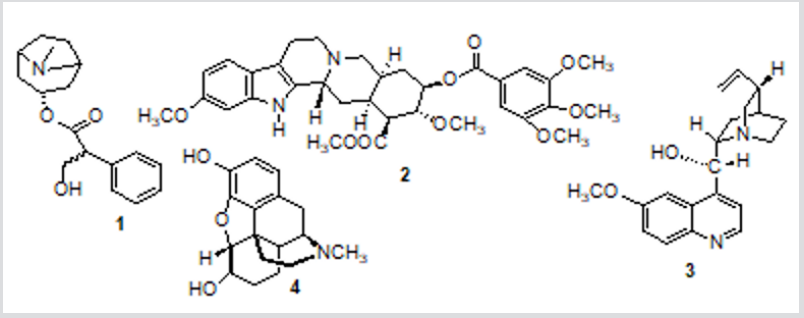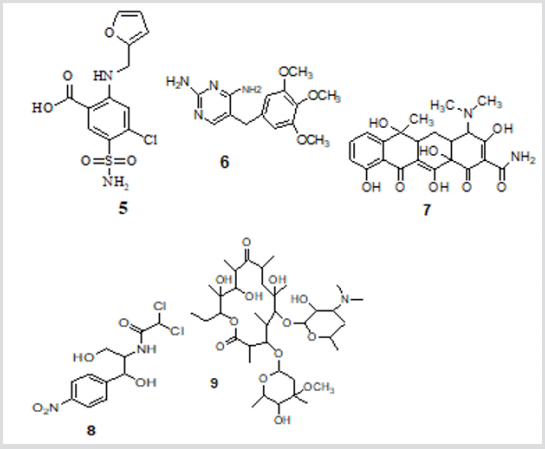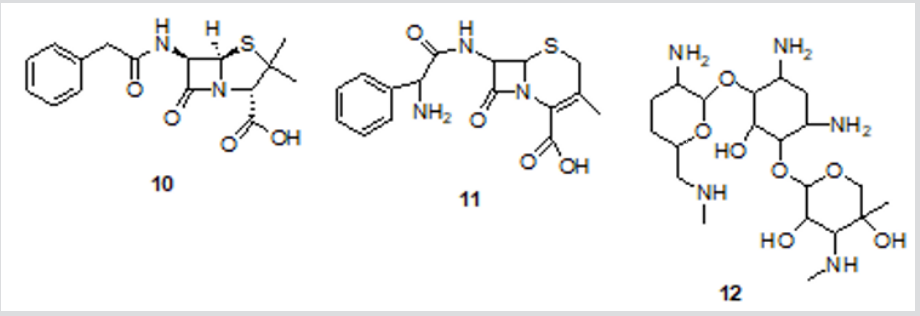Phytomedicine and Allied Compounds in Both Human and Animal Healthcare
Worldwide plants have been used for curative purposes from time immemorial. It is estimated by WHO that 80% of the population majority of this in developing countries, still rely on plant-based medicine for primary healthcare Evans [1]; Farnsworth [2]. WHO further estimated that over 80% of the population residing in developing countries depends directly on plants for their primary medical requirements Czygan [3]; WHO [4]. This is attributed to the fact that plant-derived medicines can be easily accessed and are also cheap Amin et al. [5]; Ramawat et al. [6]; WHO [5]. The use of some crude extracts whose specific evaluations have not been done could lead to serious complications, overdose and intake of toxic substances [7-10]. Ineffective herbs could also be used as a matter of belief or tradition Baker et al. [11]. In most countries, use of herbal medicine continues to coexist with modern Pharmacology Ernest [12]. The worldwide upsurge in the use of herbal preparations and active ingredients isolated from medicinal plants in healthcare Jassim et al. [13] is due to increased side effects, lack of curative treatment for several chronic diseases, high cost of new drugs, microbial resistance and emerging diseases Humber [14].
This is indicated by the growing popularity of Traditional Chinese Medicine (TCM) and Ayuverdic medicine of India Jiang et al. [15]; Dubey et al. [16]. In Africa, the use of traditional medicine is very high as indicated by the fact that between 70 and 80% of the population depend on herbal preparations for primary healthcare with little or no scientific information on efficacy and side effects Kokwaro [17-25]. Furthermore, even the people of the developed world are also dependent directly or indirectly on plants for their health care. In the United States, 25% of the prescriptions given from community pharmacies consisted of plant extracts or active ingredients of plant origin Cragg et al. [26]. In Dares Salaam, Tanzania, 21% of patients who visited public Hospitals had consulted a traditional healer before they came to hospital De Boer et al. [27]. Plant-derived medicines are offered/taken in the form of tinctures, teas, poultices and powders, depending on the knowledge of the use and application method of a particular plant for a given ailment Fennell et al. [28]; Balunas et al. [29].
It has also been demonstrated in food that Plant extracts like Polyphenols can successfully be used in food conservation thus extend self-life of such products that could otherwise go to waste due to spoilage Papuc et al. [30]. In Kenya, debate on incorporation of traditional medicine into primary health care has been going on for a while now [31-40]. There is an attempt to make a law to regulate the practice of traditional medicine by way of legislation. The Traditional Health Practitioners Bill, 2014 was published on the February 2014 and was tabled before the National Assembly by the then Chairperson of the Health Committee Rachael Nyamai. The Bill went through the first reading on 3rd June 2014 and the Committee further tabled its report on the deliberations regarding the said bill on 25th April 2015 but since then there has been no progress. If the Bill is passed into law it seeks to provide for the training, regulation and licensing of traditional practitioners so as to regulate their practice. Further, it seeks to set up traditional health practitioners’ council which is a body mandated with regulation. It also seeks to set up a Disciplinary Committee that will discipline practitioners as well as setting offenses and penalties under the said law [41-47].
Traditional societies in Africa had devised methods of providing every individual in the community with essential healthcare through acceptable and accessible means by the application of indigenous resources such as plants, animals and minerals Chhabra et al. [47]. Besides, herbal medicine takes into account every country’s socio-cultural background. the western societies have capitalized on this fact to the ignorance of other societies and either using the plant products . Of late, despite emphasis being put in research of synthetic drugs, a certain interest in medicinal plants has been reborn [48,49]. This is partly due to the fact that many synthetic drugs are potentially toxic and not free of side effects on the host and that the effectiveness of many herbal medicines is now an accepted fact Thomson [50]; Geddes [51]. Further, herbal preparations constitute valuable natural resource from which chemicals of great potential interest for medicine, agriculture, industry and other areas can be identified and isolated [52-65]. Such valuable drugs such as atropine (1), reserpine (2), quinine (3) and morphine (4) were discovered from traditional herbal remedies (Figure 1) Sneader [66], Ji et al. [67].
Figure 1: Traditional Herbal Remedies.

It is estimated that about 25% of the drugs prescribed worldwide are derived from plants and 121 such active compounds are in use Sahooetal [68]. Between 2005 and 2007, 13 drugs derived from natural products were approved in the United States. More than 100 natural product-based drugs are in clinical studies Li et al. [69], and out of the total 252 drugs in the World Health Organization’s (WHO) essential medicine list, 11% are exclusively of plant origin Sahooetal [68]. Microbiologists all over the world have been prompted to search for formulations of new antimicrobial agents and evaluation of the efficacy of natural plant products as a substitute for chemical antimicrobial agents Pandian et al. [70] Such moves have been prompted by insurmountable resistances to antibiotics that have been experienced in the past [71-85]. Many microorganisms and plants produce compounds that are not related to the basic metabolism of the producing organism called secondary metabolites as their defense mechanism. Many of these products play important roles as therapeutics and stimulants feed additives among others, Hans [86].
Medicinal plants are well-known natural sources for the treatment of various diseases since antiquity [87-90]. About 20,000 plant species used for medicinal purposes are reported by the World Health Organization (WHO) Gullece et al [91]; Maregesi [92]. Furthermore, natural products, either crude compounds, or as standardized plant extracts, provide unlimited opportunities for new drug leads because of the unmatched availability of chemical diversity Cos et al. [93]. In the past, the wide range of antimicrobial agents from lower organisms and synthetic drugs sufficed in the treatment or control of infectious diseases, but currently there is a problem of microbial drug resistance and there is an increase of opportunistic infections especially with acquired immune deficiency syndrome (AIDS) patients and individuals on immunosuppressive chemotherapy. Many antifungal and antiviral drugs are of limited use due to toxicity, while other viral diseases have not yet found a cure [94-100]. These problems pose a need of searching for more new drug substances. Most of the plants used traditionally for treatment of various ailments locally have not been studied scientifically for their efficacies and side effects Kokwaro.
Ethno-botanical information is slowly dying out due to lack of vertical transmission to young generation as people holding the information on these plants are fast dying out. There is also imminent loss of some of these plant species due to population pressure and over exploitation without proper conservation policies. Preparations, handling and storage of crude extracts from these plants could lead to decomposition or transformation into ineffective and/or harmful products Baker et al. [19], Dutra et al. [101]. In Africa, data available, indicate that medicinal plants can also be used to earn foreign exchange by exporting them to the western world Busia. It has been documented that the huge pharmaceutical significance of many tropical medicinal plants could be utilized to generate foreign exchange as well as to create jobs for many African countries [102-105]. This shows that the vast field of medicinal plants on the African continent, if harnessed, could rescue the struggling healthcare systems of most such countries Mahomoodally [106]. Some lifesaving medicines like antibiotics have their roots in plants.
Antibiotics
With the discovery of microorganisms as the causative agents of infectious diseases, many substances including those of plant origin became recognized as “antiseptics”. These are substances having the ability to inhibit the growth of microorganisms. Later on, this term was changed to “antibiotics” from the term “antibiosis”, which describes antagonism between different species and even between members of the same species in nature [107-110]. An antibiotic is a biochemical drug, derived from one or more kinds of microorganisms. It may have the ability to inhibit the growth of (bacterial static agent) or to kill (bactericidal agent) a number of other microorganisms. This makes antibiotics be of immense value in the treatment of a number of diseases that result from microbial infection Amit et al. [113]. Antibiotics, also known as antimicrobial drugs are therefore drugs that fight infections caused by bacteria, either by inhibiting the growth of or by destroying these microbes. Their therapeutic success relies on their pharmacokinetic behavior and the contribution that the host’s own defenses are able to make towards clearance of the offending microorganism Amit et al. [113].
Bacteriostatic Agents
After the discovery of Penicillin in 1929, it was a wonder drug and an immediate solution to bacterial infections. Since the several derivatives have discovered or synthetically evolved in laboratories that also led to their categorisation into Bacteriostatic and Bactericidal agents. Bacteriostatic agents are substances that inhibit the growth of other microorganisms by interfering with bacterial protein production, bacterial DNA production and bacterial cellular metabolism (Figure 2). Bacteriostatic antibiotics inhibit growth and reproduction of bacteria without killing them and killing is done by the bactericidal agents. Examples of synthetic bacteriostatic agents include; sulphonamides like furosemide (5), trimethoprim (6), tetracycline (7), chloramophenicol (8) and erythromycin (9) and their derivatives among others Sritharan et al. [114].
Figure 2: Bacteriostatic agents.

Bactericidal Agents
Bactericides act as disinfectants, antiseptics or antibiotics (Figure 3). They include; benzylpenicillin (10), cephalosporins like cefalexin (11) and amino-glycosides like gentamicin (12) (Sritharan and Sritharan, 2004). Effective chemotherapy in the use of antibiotics depends upon selective toxicity, which is their ability to inhibit microorganisms at concentrations tolerated by the host Amit et al. [113].
Figure 3: Bactericidal agents.

Active Compounds in Plant Extracts
Plants produce biologically active secondary metabolites often with highly complex chemical structures. These compounds are concerned with survival of the plants and are known to have antimicrobial activity Waterman [115]. The compounds vary from plant to plant and are found to be in different concentrations in different parts of the same plant Lawrence [116]. The combined effects of the health-related challenges due to the rapidly growing population, emergence of antimicrobial resistant pathogenic strains to frequently used commercial drugs such as penicillin, increased side effects, the failure of modern medicine to provide effective treatment, high cost of new drugs and emerging diseases, research into natural products with anti-microbial activity is being pursued in earnest. It is of importance to establish a scientific basis for the use and validation of medicinal plants through biological screening. Populations living in developing countries depend directly on herbal drugs and traditional medicines for primary healthcare WHO [4].
Many of the drugs which are in use today were discovered through their ethno-botanical route Kareru et al. [117]. Moreover, pathogen resistance to existing drugs coupled with increased side effects, lack of curative treatment for several chronic diseases, high cost of drugs and emerging diseases is very common in today’s world Humber [14]. This makes it necessary to research on medicinal plants in order to obtain more and potent pharmacological agents owing to the fact that natural products and their related moieties have historically been incredible as a source of therapeutic agents Koehn et al. [118].
To conclude, let say that phytomedicine is they and loud but the allopathic medicine does not want to hear and say.
3D Printing for Genetic Mouse Models of Congenital Heart Disease-https://biomedres01.blogspot.com/2021/02/unexpected-honeycomb-like-structural.html
More BJSTR Articles : https://biomedres01.blogspot.com


No comments:
Post a Comment
Note: Only a member of this blog may post a comment.